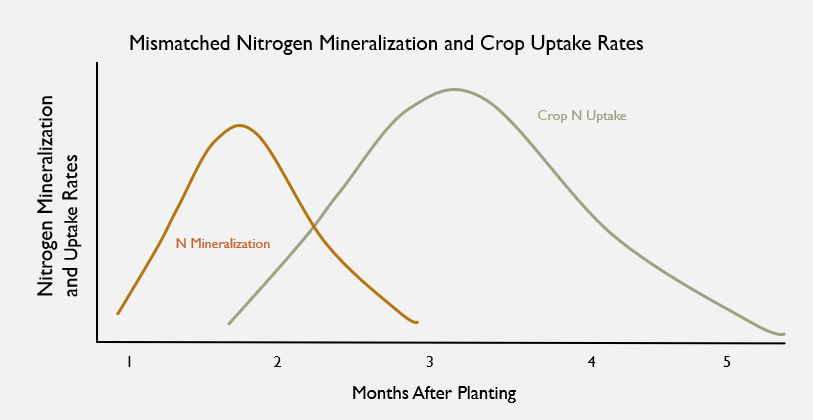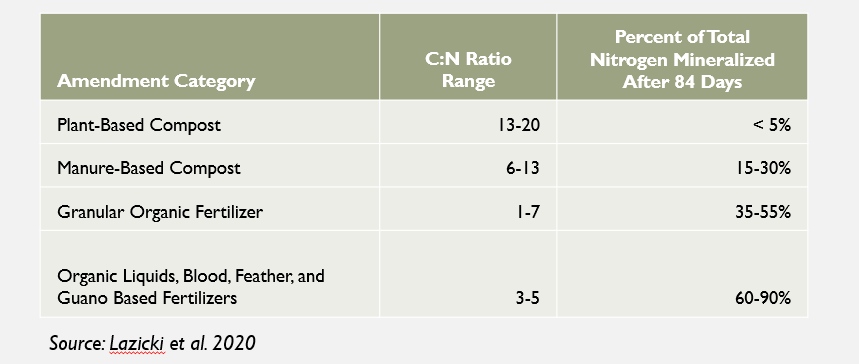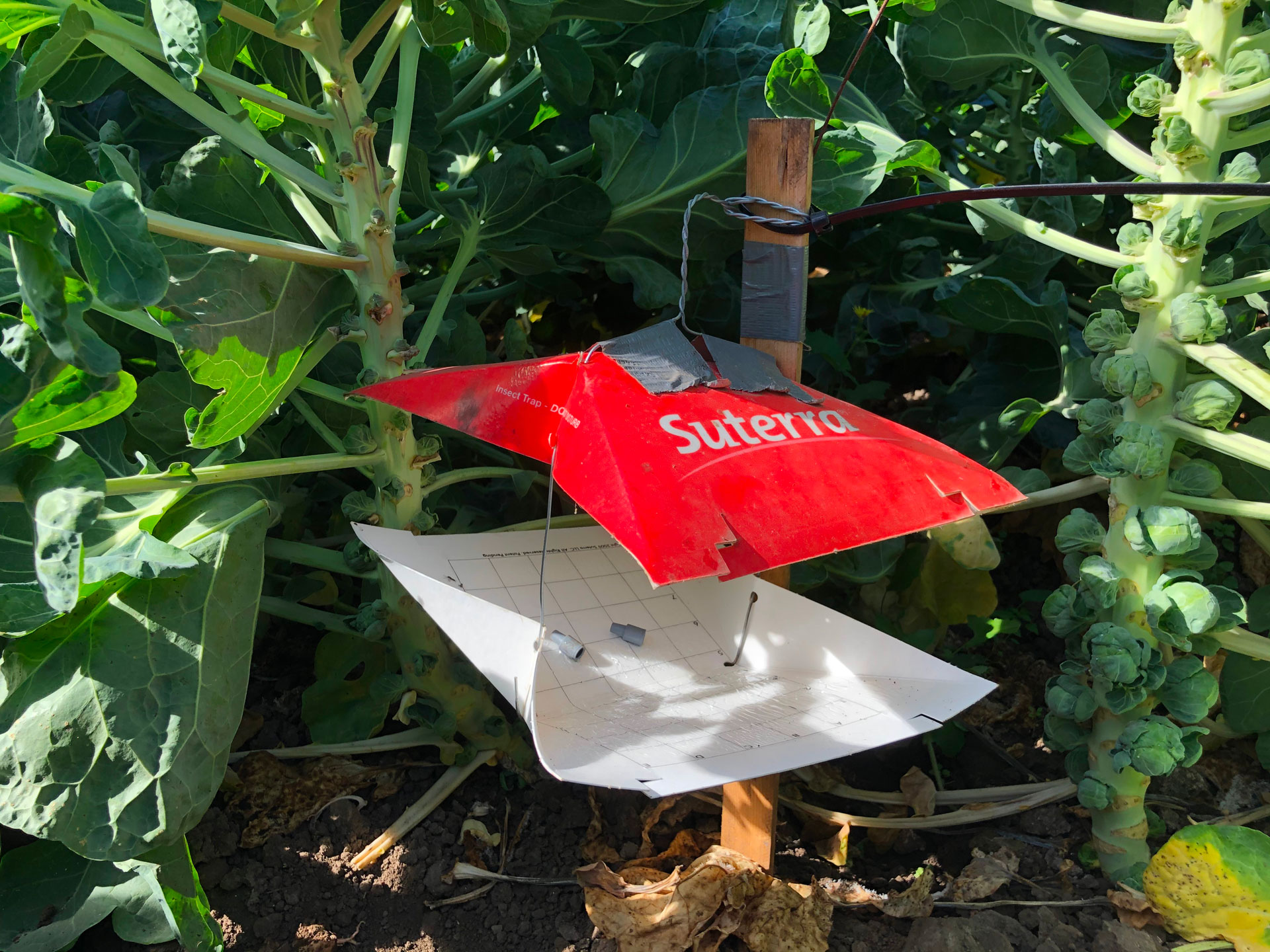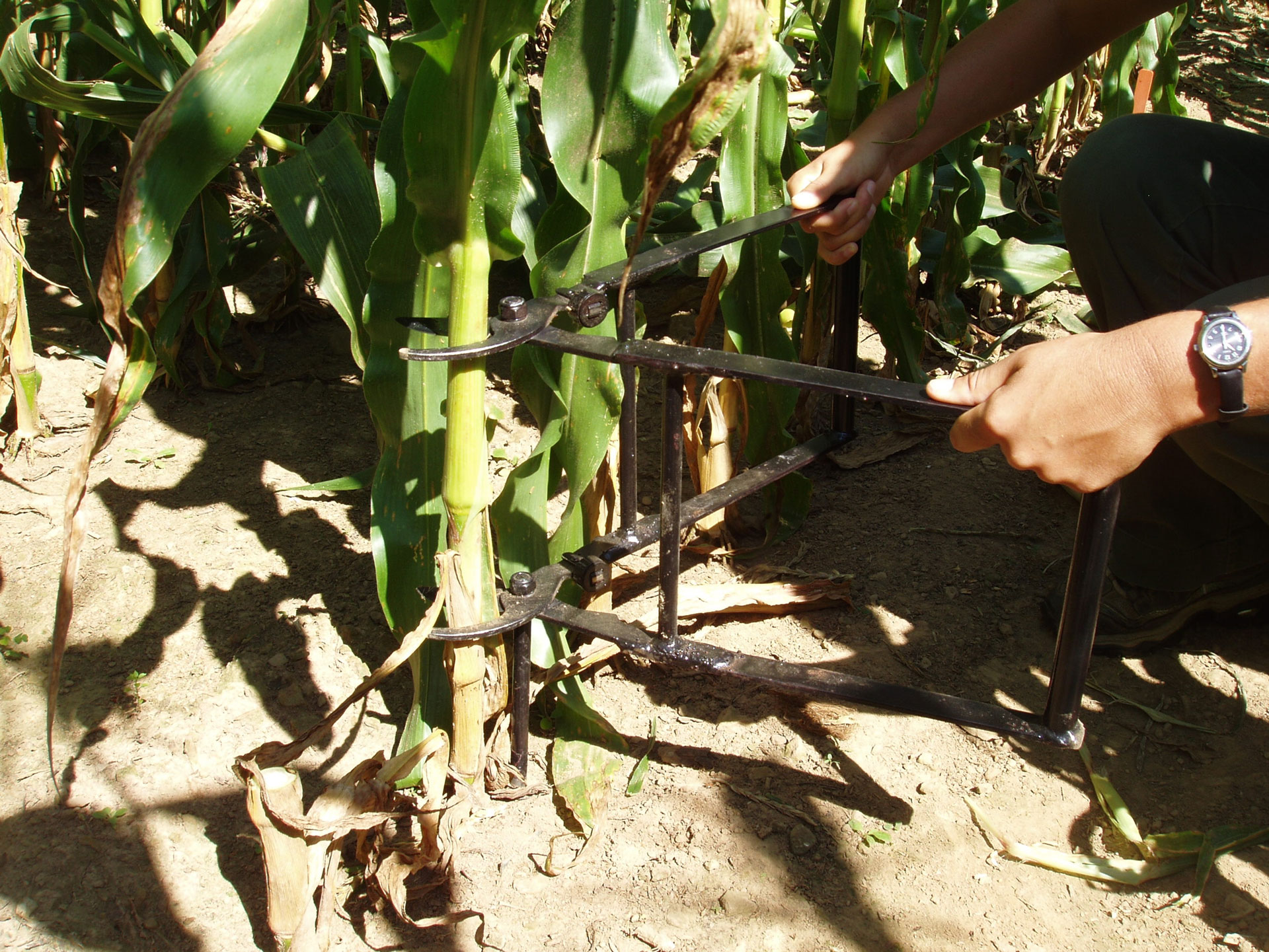
Before Haber and Bosch invented atmospheric nitrogen fixation, farmers used manure, compost, cover crops and crop rotations to keep their soils fertile. Farmers relied on biological processes to feed their crops, and limited nitrogen availability often compromised yields. Mineral N fertilizer revolutionized farming, bypassing microbial decomposition to directly feed the crop surplus levels of nitrogen. Virtually unlimited nitrogen availability produced drastically higher yields, but the excess N began polluting groundwater, rivers, wetlands and oceans.
The green revolution demonstrated agricultural crops’ impressive yield potential and heightened consumers’ quality expectations. Modern organic practices seek to minimize nitrogen pollution while attaining yield and crop quality metrics comparable to conventionally produced crops. Carbon-based organic materials provide initial protection against nitrate leaching when first applied; however, once microbes convert organic N to nitrate, it leaches just as easily. Over-applying quickly mineralizing organic fertilizers negates any environmental benefit provided by organic amendments.
Keep it “Tight”
The most efficient, environmentally protective fields have “tight” nitrogen cycles, where nitrate levels remain low, yet crops grow vigorously with optimum N concentrations in leaves and petioles1. Since nitrogen fluxes between several biological and mineral pools, traditional soil nitrate testing does not always indicate nitrogen sufficiency or deficiency in organic production. In the best-case scenario, active microbial populations steadily release N to the crop, and healthy root systems quickly absorb nitrate and ammonium before it builds up in soil solution1.
Nitrogen requirements are well understood for most agricultural crops, and N uptake curves usually help guide fertilizer application rates. In conventional production, growers can match the nitrogen uptake curve by adjusting nitrate and ammonium applications to meet the demand at different growth stages. Organic producers don’t have the luxury of matching the crop’s N requirement pound for pound with fertilizer. Organic amendments supply nitrogen in carbon-based forms that must be processed by microbes before becoming available to plants. Bacteria break down amino acids, proteins and peptides, mineralizing organic nitrogen to form ammonium. Other microbes then quickly transform ammonium to nitrate through nitrification. Yield and crop quality largely depend on how closely nitrogen mineralization timing matches the crop’s N uptake curve.
Applied Amendments
While soil quality and environmental conditions influence mineralization, the type of organic amendment applied impacts nitrogen availability more than any other factor. Meticulous soil incubation studies conducted at UC Davis elucidate the nitrogen mineralization patterns driven by commonly used organic fertilizers. Dr. Patricia Lazicki and colleagues identified four main amendment categories based on nitrogen mineralization potential6. Organic amendment categories include (1) yard trimmings compost, (2) manure composts, (3) granular fertilizers and (4) liquids, blood and feather meal and guano-based fertilizers6.
Growers can apply material from one category or another to address different needs throughout the year. Fertilizers with high C:N ratios mineralize slowly compared to materials containing less carbon and more nitrogen. Lazicki et al. found that less than 5% of the total N in yard trimming compost mineralized after 84 days of soil incubation at moisture and temperature levels comparable to California field conditions. Green waste compost has a C:N ratio of roughly 20:1 and contains relatively little N compared to carbon. Microbial growth increases in response to the carbon, but is limited by a short nitrogen supply. Microbes incorporate the nitrogen into their biomass, temporarily removing it from the plant-available pool.
Manure- and animal-based amendments contain more nitrogen and have lower C:N ratios, so microbial growth slows due to limited carbon supply, leaving excess nitrogen available to plants. Soil incubation demonstrated 15% to 30% N mineralization for manure-based compost applications and 35% to 55% mineralization when granular organic fertilizers were used. Category 4, including organic liquid fertilizers, blood and feather meal and guano products, had the highest total mineralization. 60% to 90% of nitrogen applied with the amendment was mineralized after 84 days. Almost all mineralization occurred in the first two to three weeks after application. Several other studies demonstrated similar mineralization rates for organic fertilizers2,3,⁴,⁵.
Organic liquids and animal based products help meet the crop’s nitrogen requirement during rapid growth when the roots take up more nitrogen than baseline mineralization can supply. Adding moderate amounts of liquid organic fertilizer improves yield and crop quality, but excessive use can cause nitrate buildup and leaching. On the other end of the spectrum, applying green waste compost too close to planting can cause nitrogen immobilization and subsequent deficiency in the crop.

Manage Microbes
Growers can tighten the nitrogen cycle by increasing organic matter, increasing microbial abundance and diversity, and maintaining optimum soil moisture. Soils with low baseline microbial activity are prone to nitrate spikes and crashes when fed organic amendments. The carbon and nitrogen influx can cause a temporary spike in microbial growth, immobilizing N as it is incorporated into microbial bodies. Later, when the microbes run out of food, their populations crash, releasing excess N to the crop. Increasing microbial biomass and diversity buffers the nitrogen supply. Large, robust soil ecosystems contain some populations that are growing and others that are dying. The continuous microbial turnover provides a steady nitrogen supply, reducing the likelihood of nitrogen spikes and crashes.
Providing plenty of labile carbon and nitrogen can increase microbial biomass and stabilize nitrogen dynamics1. Growers can apply green waste compost pre-plant or in the fall prior to spring planting. The high C:N ratio will likely cause initial nitrogen immobilization followed by slow mineralization. Green waste compost contributes very little plant-available nitrogen during the first year after application, but it increases the microbial biomass necessary for steady nitrogen cycling. Cover crops and reduced tillage also increase organic matter and microbial growth.
After feeding the microbes, growers can feed the crop with granular and liquid organic fertilizers that mineralize quickly. Low C:N ratio materials should be applied early in the season and during rapid growth. Apply liquid organic fertilizers at moderate rates every 7 to 14 days during peak vegetative growth. Including a wide range of amendments in organic systems will increase microbial biomass and soil organic matter while providing plenty of plant-available nitrogen when crops need it the most. By carefully managing organic fertilizer use and fostering a robust microbial community, growers can provide all the environmental benefits organic farming offers without compromising crop yield or quality.
Eryn Wingate is an agronomist with Tri-Tech Ag Products Inc. in Ventura County, Calif. Eryn creates nutrient management plans for fruit and vegetable growers to improve yield and crop quality while promoting soil health and environmental protection.
Sources
- Bowles TM, Hollander AD, Steenwerth K, Jackson LE (2015) Tightly-Coupled Plant-Soil Nitrogen Cycling: Comparison of Organic Farms across an Agricultural Landscape. PLoS ONE 10(6): e0131888. https://doi.org/10.1371/journal.pone.0131888
- Gaskell, M., & Smith, R. (2007). Nitrogen Sources for Organic Vegetable Crops, HortTechnology hortte, 17(4), 431-441. https://journals.ashs.org/horttech/view/journals/horttech/17/4/article-p431.xml
- Hadas, A. and L. Kautsky. (1994) Feather meal, a semi-slow release nitrogen fertilizer for organic farming. Fert. Res. 38: 165–170.
- Hartz, T. K., & Johnstone, P. R. (2006). Nitrogen availability from high- nitrogen-containing organic fertilizers. HortTechnology, 16, 39–42. https://doi.org/10.21273/HORTTECH.16.1.0039
- Hartz, T. K., Smith, R., & Gaskell, M. (2010). Nitrogen availability from liquid organic fertilizers. HortTechnology, 20, 169–172. https://doi.org/10.21273/HORTTECH.20.1.169
- Lazicki, P, Geisseler, D, Lloyd, M. (2020) Nitrogen mineralization from organic amendments is variable but predictable. J. Environ. Qual. 49: 483–495. https://doi.org/10.1002/jeq2.20030





